Complete Solutions to Illustrative Example of chapter GEOMETRICAL OPTICS of Class 12 book with complete answers and questions
| Class 12 | PHYSICS |
| Chapter | GEOMETRICAL OPTICS |
| PHYSICS GALAXY | Illustrative Example |
| Number Of Questions | 89 |
| Academic Year | 2023-24 |
A ray of light is incident on the (y-z) plane mirror along a unit vector `hate_(1) = (1)/(sqrt(3)) hati +(1)/(sqrt(3)) hatj +(1)/(sqrt(3))hatk`. Find the unit vector along the reflected ray.
04:31View SolutionTwo plane mirrors are combined to each other as such one is in (y-z) plane and other is in (x-z)plane.A ray of light along vector `(1)/(sqrt(3)) hati +(1)/(sqrt(3))hatj +(1)/(sqrt(3))hatk` is incident on the first mirror. Find the unit vector in the direction of emergence ray after successive reflections through these mirros.
02:25View SolutionA ray of light is incident on a plane mirror along a vector `hat i+hat j- hat k.`
The normal on incidence point is along `hat i+ hat j `.Find a unit vector along the
reflected ray.02:00View SolutionFigure shows a mirror M on which a light ray incident at an angle `40^(@)` from normal. If the ray is rotated by `10^(@)` clockwise find the change in angle of deviation of light after reflection.
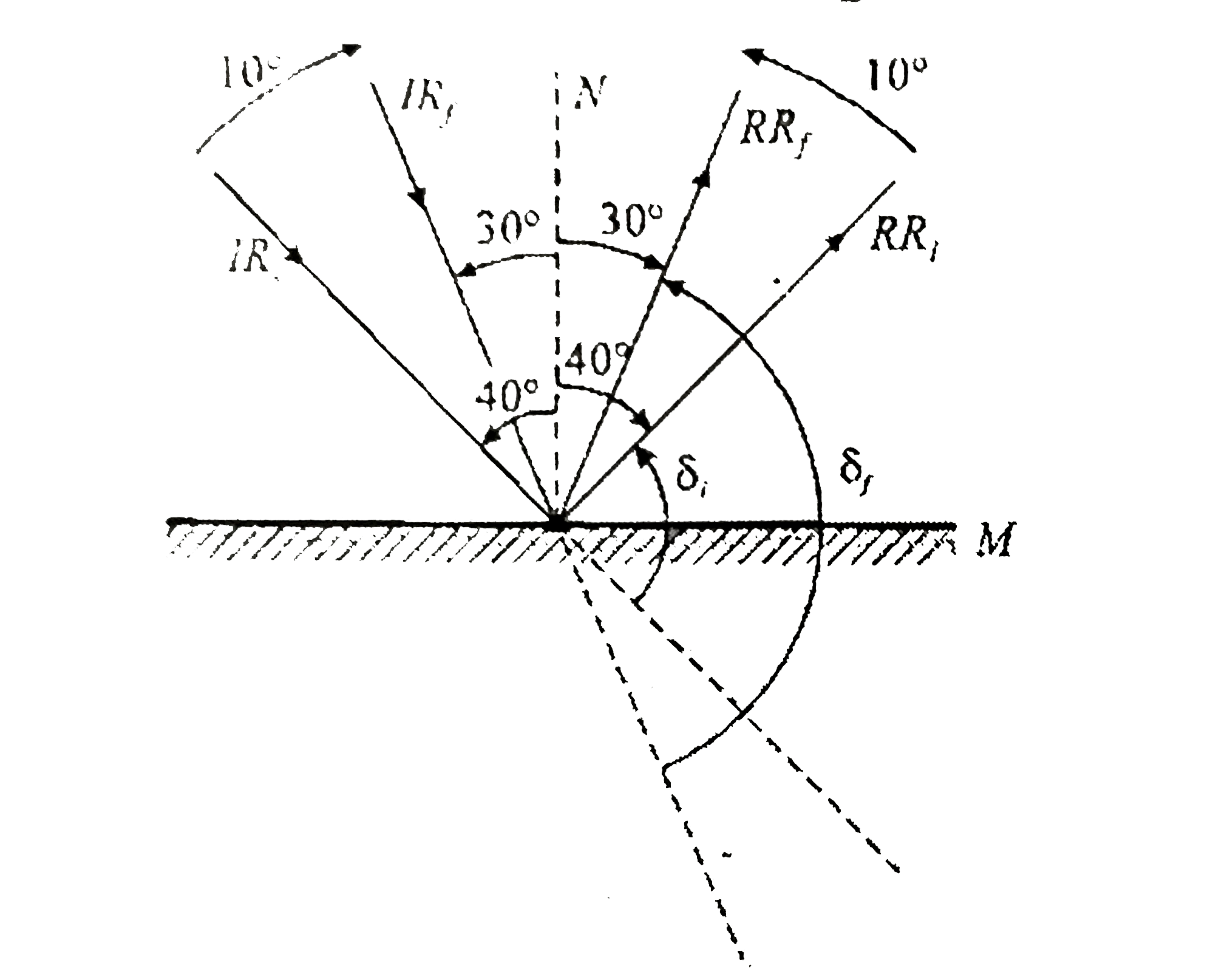 02:00View Solution
02:00View SolutionA man is standing in aroom of length 20m and height 3m at a distance 5m from one wall. On the facing wall a mirror is hanging. Find the minimum size of mirror required in which man will be able to see complete height of wall behind him.
03:37View Solutionrays of light strike a horizontal plane mirror at an angle of `45^(@)`. At what angle should be a second plane mirror be placed in order that the reflected ray finally be reflected horizontally from the second mirror.
03:14View Solution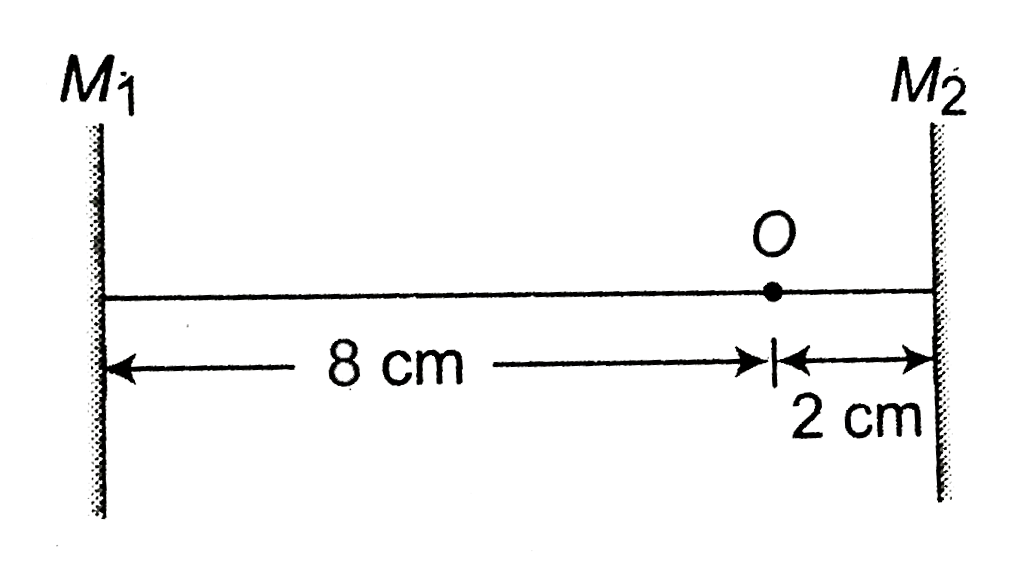
Figure shows two plane mirrors and an object O placed between them what will be distance of the first three imgages from the mirror `M_2`?02:39View SolutionDemostrate that a light beam reflected from three mutually perpendicular plane mirrors in succession reverses its direction.
05:23View SolutionFigure shows a torch producing a straight light beam falling on a plane mirror at an angle `60^(@)` The reflected beam makes a spot P on the screen along y-axis . If at t=0, mirror starts ratating about the hinge A with an angular velocity `(omega)=1^(@)` per second clockwise. Find the speed of the spot on screen after time t = 15 s.
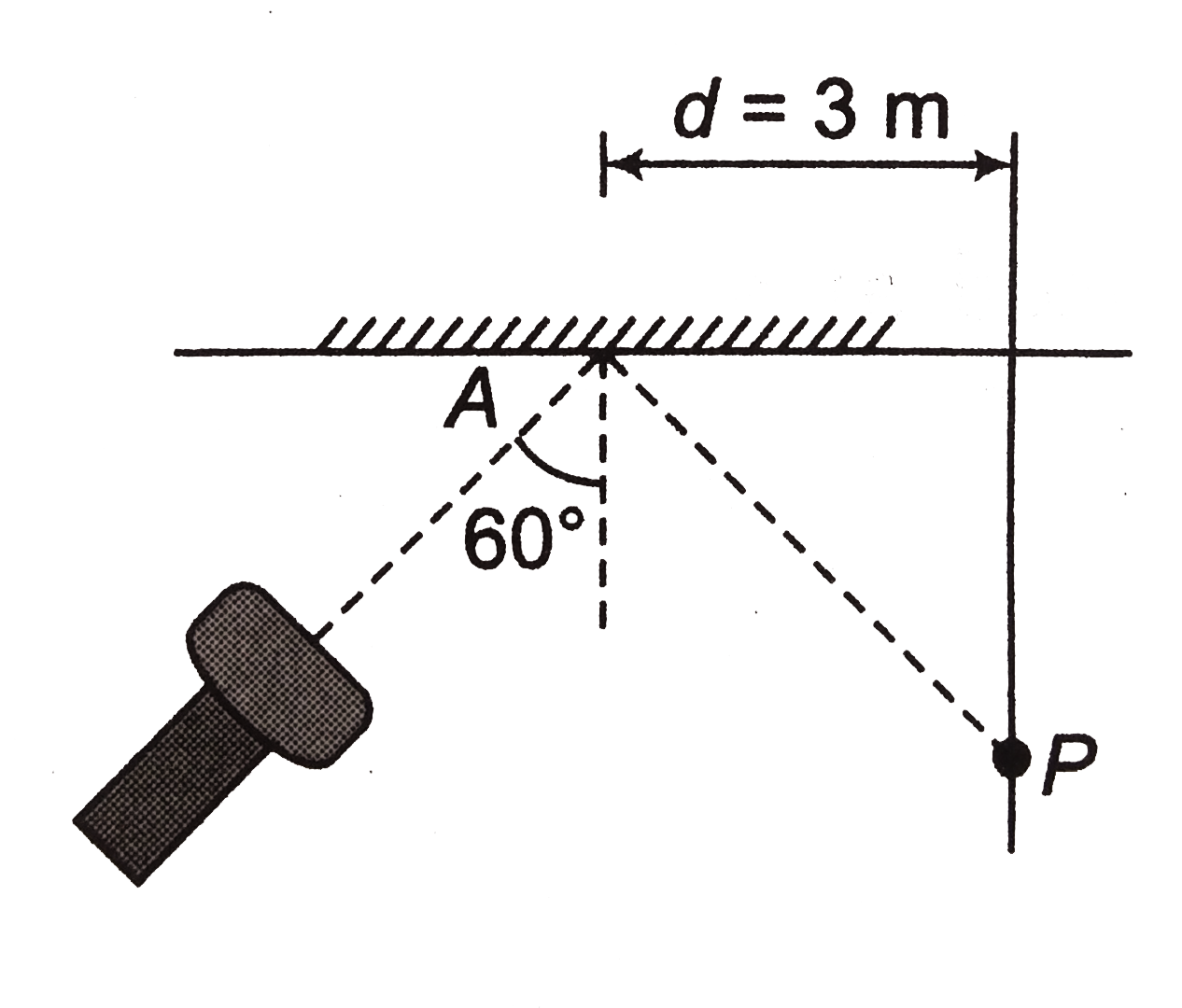 04:09View Solution
04:09View SolutionFigure shows a plane mirror onto which a light rays is incident. If the incident light ray is rotated by `10^(@)` and the mirror by `20^(@)`, as show in figure below, find the angle by which the reflected ray is rotated.
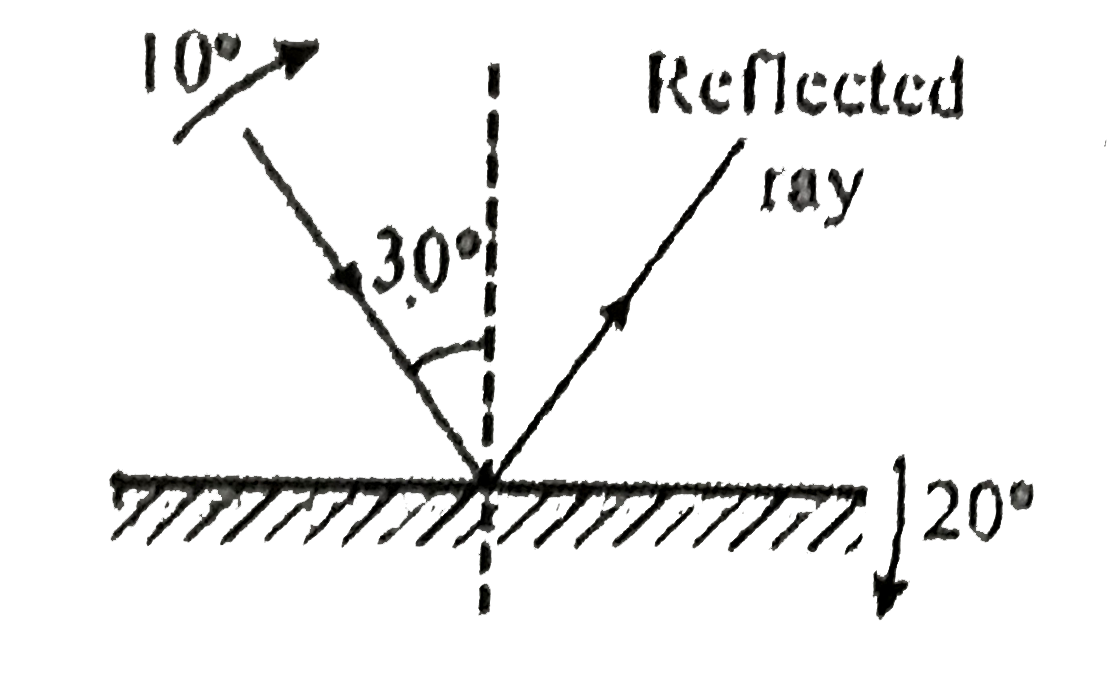 02:54View Solution
02:54View SolutionA point object is placed at a distance 30 cm in front of a concave mirror of focal length 20 cm. Find the nature and location of image obtained.
02:25View SolutionA thin rod of length `d//3` is placed along the principal axis of a concave mirror of focal length = d such that its image, which is real and elongated, just touches the rod. Find the length of the image ?
05:05View SolutionIn figure shown find the distance from pole P of the concave mirror shown in figure, at which when a plane mirror is placed, image produced by both mirror for the object O will coincide.
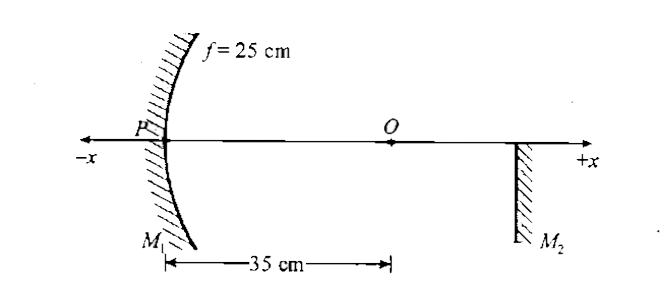 03:07View Solution
03:07View SolutionAn observer whose least distance of distinct vision is 'd' views the his own face in a convex mirror of radius of curvature 'r' .Prove that magnification produced can not exceed `(r )/(d+sqrt(d^(2)+r^(2)) `
08:24View SolutionAn object is placed in front of a convex mirror at a distance of 50cm. A plane mirror is introduced covering the lower half of the convex mirror. If the distance between the object and the plane mirror is 30cm, it is found that there is no parallax between the images formed by the two mirrors. What is the radius of curvature of the convex mirror?
01:41View SolutionUsing a certain concave mirror, the magnification is found to be 4 times as great when the object was 25 cm from the mirror as it was with the object at 40 cm from the mirror, the image, being real in each case.Find the focal length of the mirror.
03:06View SolutionA concave and a convex mirror each 30 cm in radius are placed opposite to each other 60 cm apart on the same axis. An object 5cm in height is placed midway between them. Find the position and size of the image formed by two successive reflections, consider first reflection at convex and then at the concave mirror.
03:17View SolutionA thief is running away in a car with velocity of `20 m//s`. A police jeep is following him, which is sighted by thief in his rear view mirror, which is a convex mirror of focal length 10 m. He observes that the image of jeep is moving towards him with a velocity of `1 cm//s`. if the magnification of mirror for the jeep at that time is `1/10`. Find
(a) the actual speed of jeep,
(b) rate at which magnification is changing.
Assume the police's jeep is on the axis of the mirror.04:04View SolutionA Convex mirror of radius of curvature R is fixed on a standat rest with total mass m which is facing a block of equal mass m as shown in figure and is kept on a frictionless horizontal surfece. The separation between the block and mirror is 2R and block is moving at a speed v toward the mirror. Consider elastic collision between block and stand, find the speed of image after time `3R//v`.
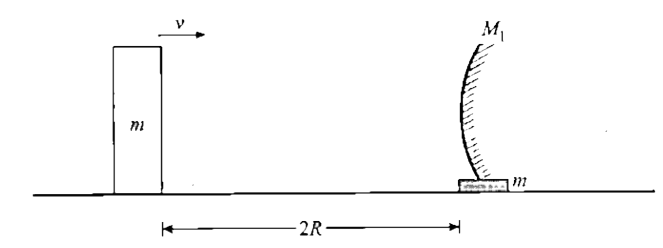 06:19View Solution
06:19View SolutionA concave mirror of focal length `20 cm` is cut into two parts from the middle and the two parts are moved perpendicularly by a distance `1 cm` from the previous principal axis `AB` .find the distance between the images formed by the two parts?
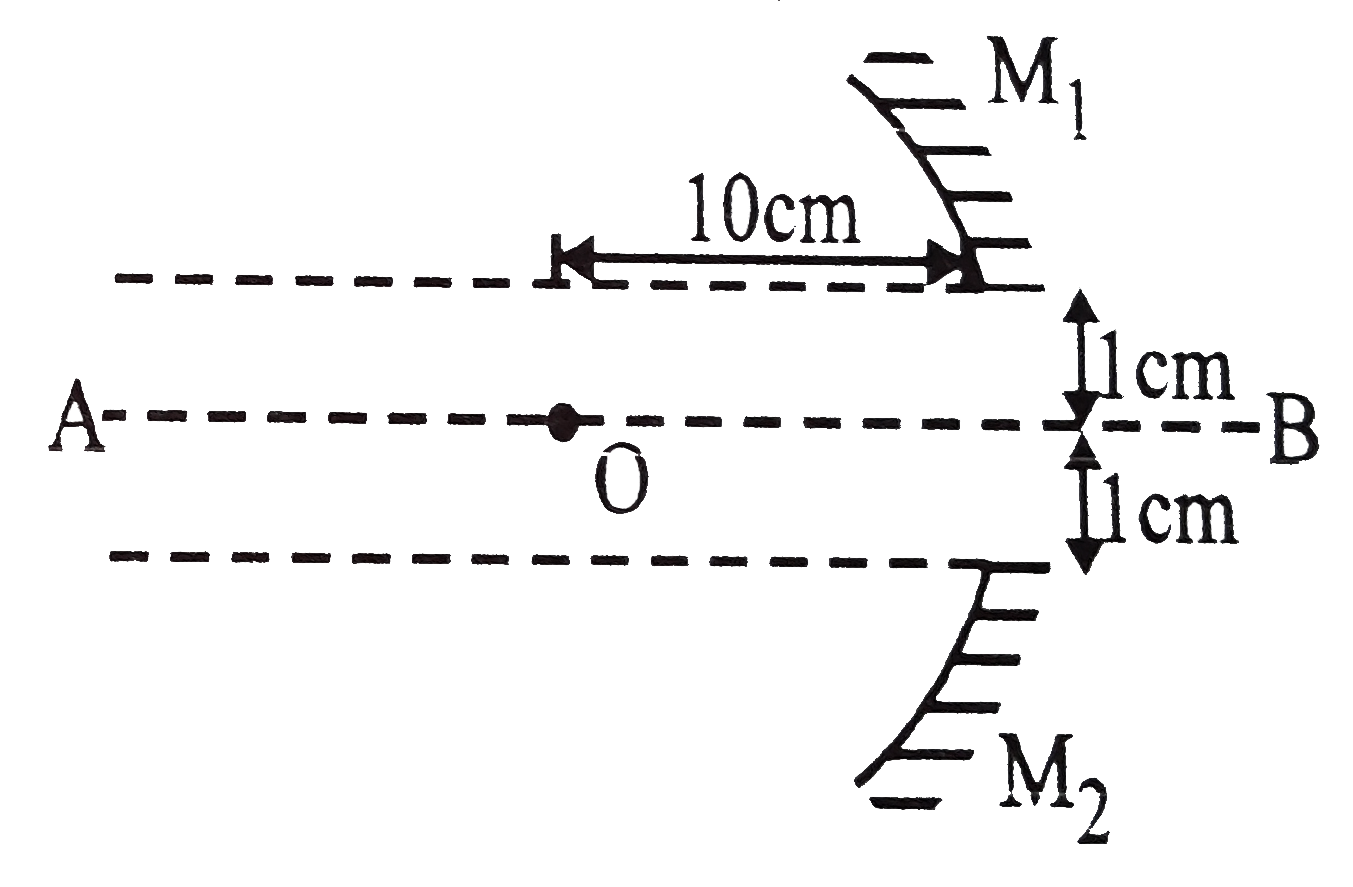 06:41View Solution
06:41View SolutionAn object is located at a distance 30cm on principal axis from the pole of a concave mirror of focal length 20cm. Suddenly the mirror is displaced by a distance 1.5 cm in the direction normal to its principal axis. Calculate the displacement of image produced by the mirror due to this.
03:35View SolutionA converging beam of light rays incident on a glasa-air interface as shown in figure. Find where these rays will meet after refraction.
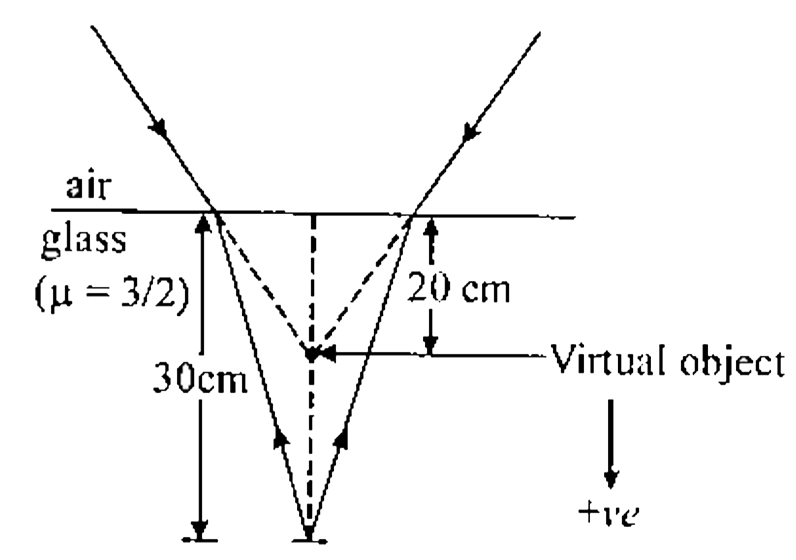 03:37View Solution
03:37View SolutionA concave mirror is placed inside water its shining surface upwards and principal axis vertical as shown in figure. Rays are incient parallel to the principal axis of the concave mirror. Find the position of the final image.
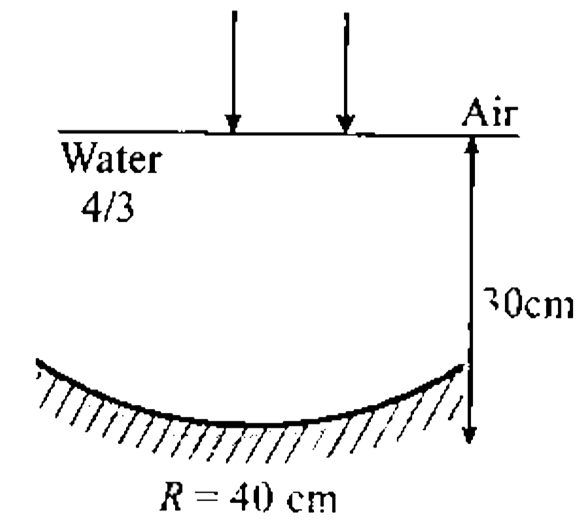 04:30View Solution
04:30View SolutionA bird in air is dividing vertically over a tank with speed `6 cm//s`. The base of the tank is silvered. The fish in the tank is rising upward along the same line with speed `4 cm//s`. (Take: `mu_("water") = 4//3)`. Find:
(a) The speed of the image of the fish asseen directly by the bird.
(b) The speed of the image of the bird relative to the fish looking upwards.05:04View SolutionFigure shows a concave mirror of focal length F with its principal axis vertical. In mirror a transparent liquid of refractive index `mu` is filled upto height d. Find where on axis of mirror a pin should be placed so that its image will be formed on itself.
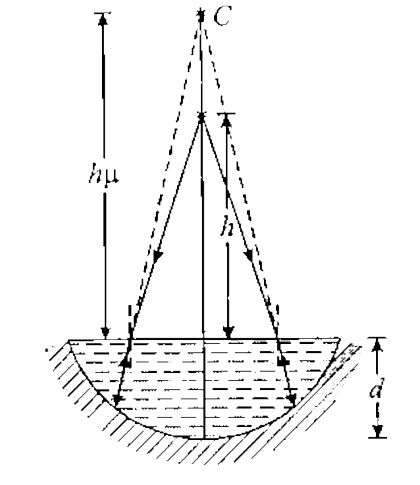 04:55View Solution
04:55View SolutionThe XY plane is the boundary between two tranparednt media. Medium 1 with `z ge 0` has a refraxtive index of `sqrt2` and medium 2 with `z le 0` has a refractive index of `sqrt3`. A ray of light in medium 1 given by the vector `6sqrt(3)hat(i)+8sqrt(3)hat(j)-10hatk` is incident on teh plane of separation. Find the unit vector in the direction of teh refracted ray in medium 2.
06:28View SolutionConsider the situation shown in figure. A plane mirror is fixed at a height h above the bottom of a beaker containing water (refractive index `mu`) up of a bottom formed by the mirror.
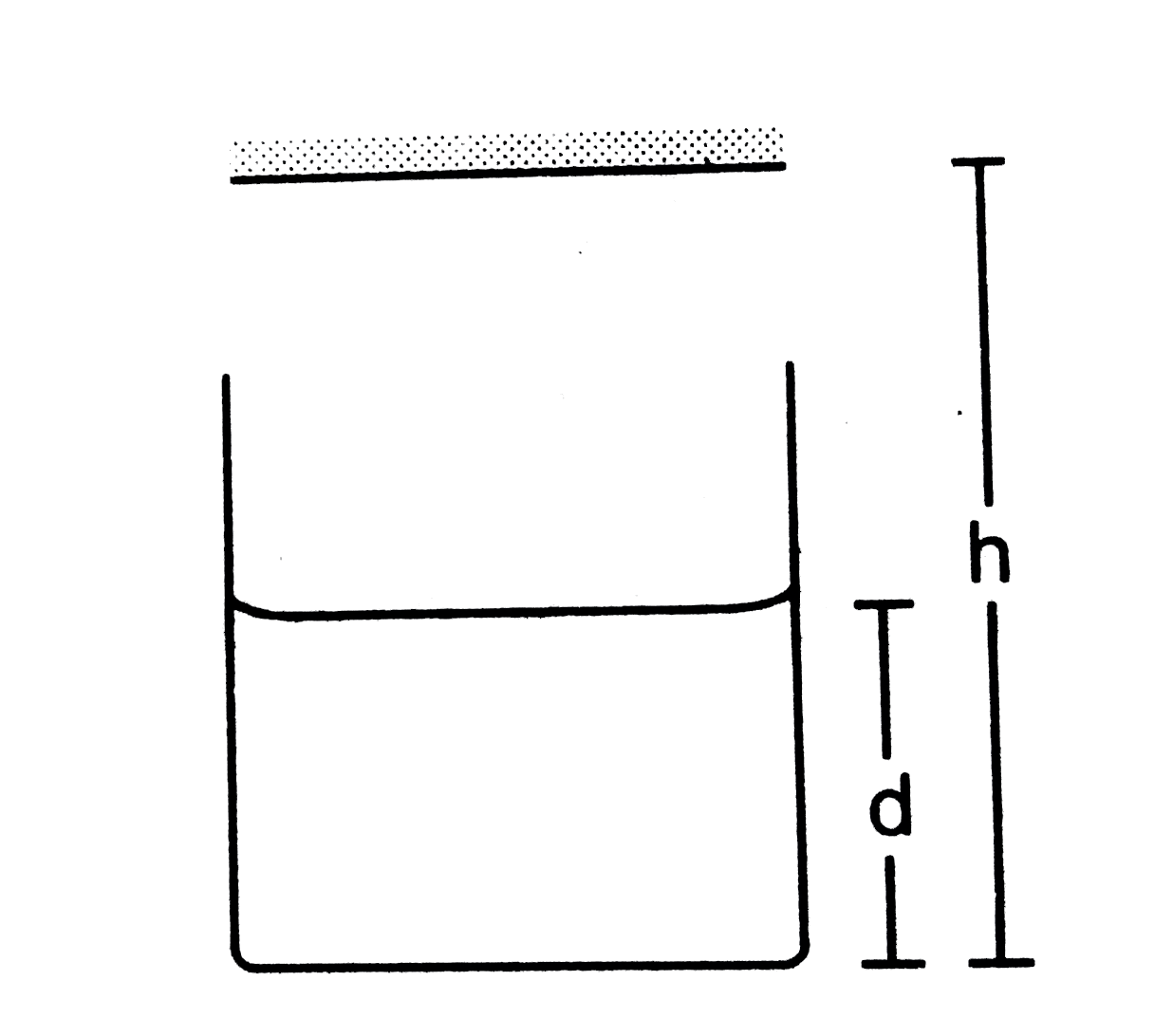 02:08View Solution
02:08View SolutionA rectangular glass block of thickness 10 cm and refractive index 1.5 placed over a small coin. A beaker is filled with water of refractive index `4//3` to a height of 10 cm and is placed over the glass block.
(a) Find the apparent position of the object when it is viewed at near normal incidence.
(b) if the eye is slowly moves away from the normal at a certain position, the object is found to disappear, due to total internal reflection. At what surface does this happen and why ?10:22View SolutionA glass slab of thickness 3cm and refractive index 1.5 is placed in front of a concave mirror of focal length 20cm. Where should a poing object be placed if it is to image on to itself?
01:57View SolutionA concave mirror has the form of a hemisphere with a radius of `R=60cm` A thin layer of an unknown transparent liquid is poured into the mirror ,The mirror-liquids system forms one real Image and another real image is formed by mirror alone ,with the sources in a certain position .One of them coincides with the source and the other is at distance of `l=30 cm` from source.find the possible value(s) refractive index `mu`of the liquid.
18:45View SolutionIn previous illustrations if image formed by the mirror coincides with the source and that produced by the combination is produced at a distance 30 cm from the source away from mirror then find the refractive index of the liquid.
05:04View SolutionA person looking through a telescope T just sees the points on the rim at the bottom of a cylindrical vessel when the vessel is empty. When the vessel is completely filled with a liquid `(mu, = 1.5)`, he observes a mark at the centre B,of the bottom without moving the telescope or the vessel. What is the height of the vessel if the diameter of it scross section is 10cm.
06:56View SolutionAn object is placed `20cm` in front of a block of glass `10cm` thick having its farther side silvered. The image is formed `23.2cm` behind the silvered face. The refractive index of glass is
03:33View SolutionA light ray from air is incident on a glass plate of thickness t and refractive index `mu`at an angle of incidence equal to the angle of total internal reflection of glass. Compute the displacement of the ray due to this plate in terms of thickness and refractive index of glass `mu`.
04:24View SolutionA concave mirror of radius 40 cm lies on a horizontla tale and wateis filled in it up t a heightof 5.00 cm. A small dust particle floats on the water surface at a point P vertically above tge pointof contact of the miror with the table. Locate the image of the dust particle as seen from a point directly above it. tEh refractie index of water is 1.33.
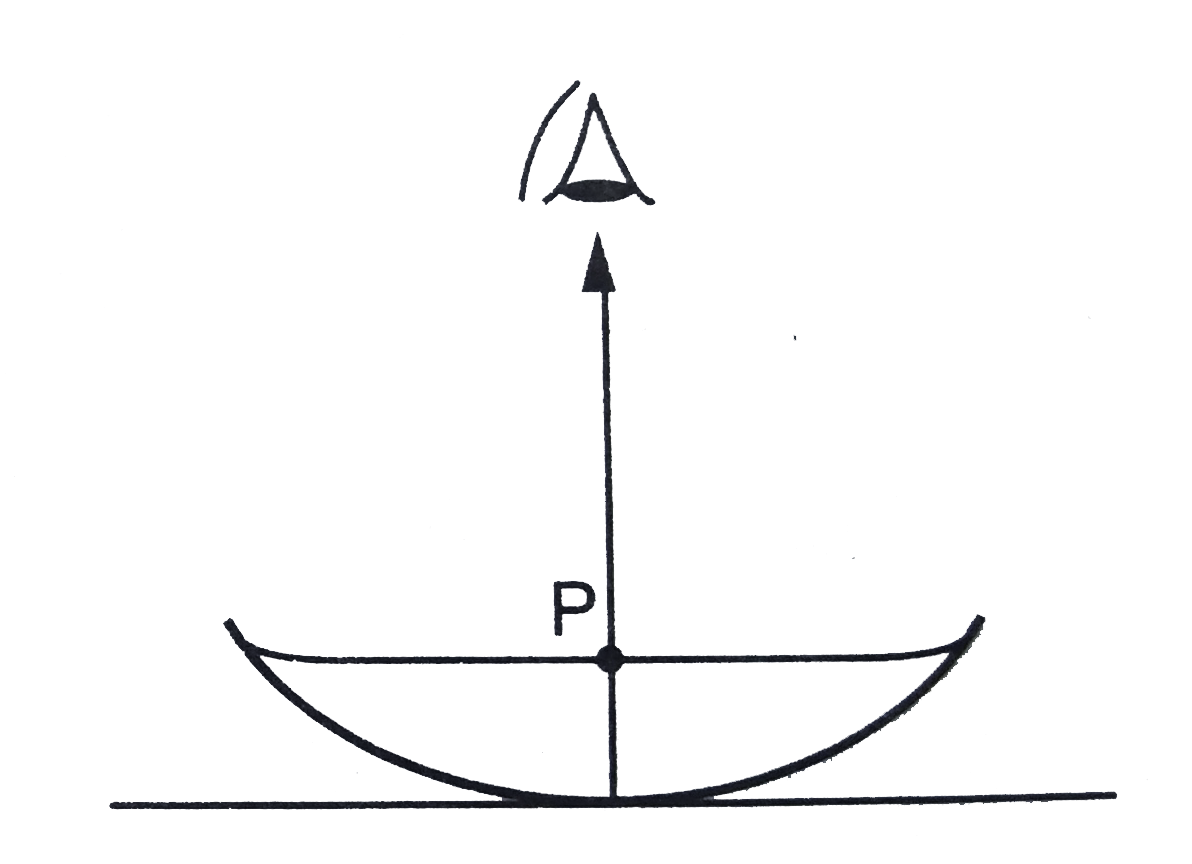 05:10View Solution
05:10View SolutionFigure shows a glass sphere of radius 10 cm. along its diameter AB from one side a parallel beam of paraxial rays incident on it. What should be the refractive index of glass so that after refraction all rays will converge at opposite end B.
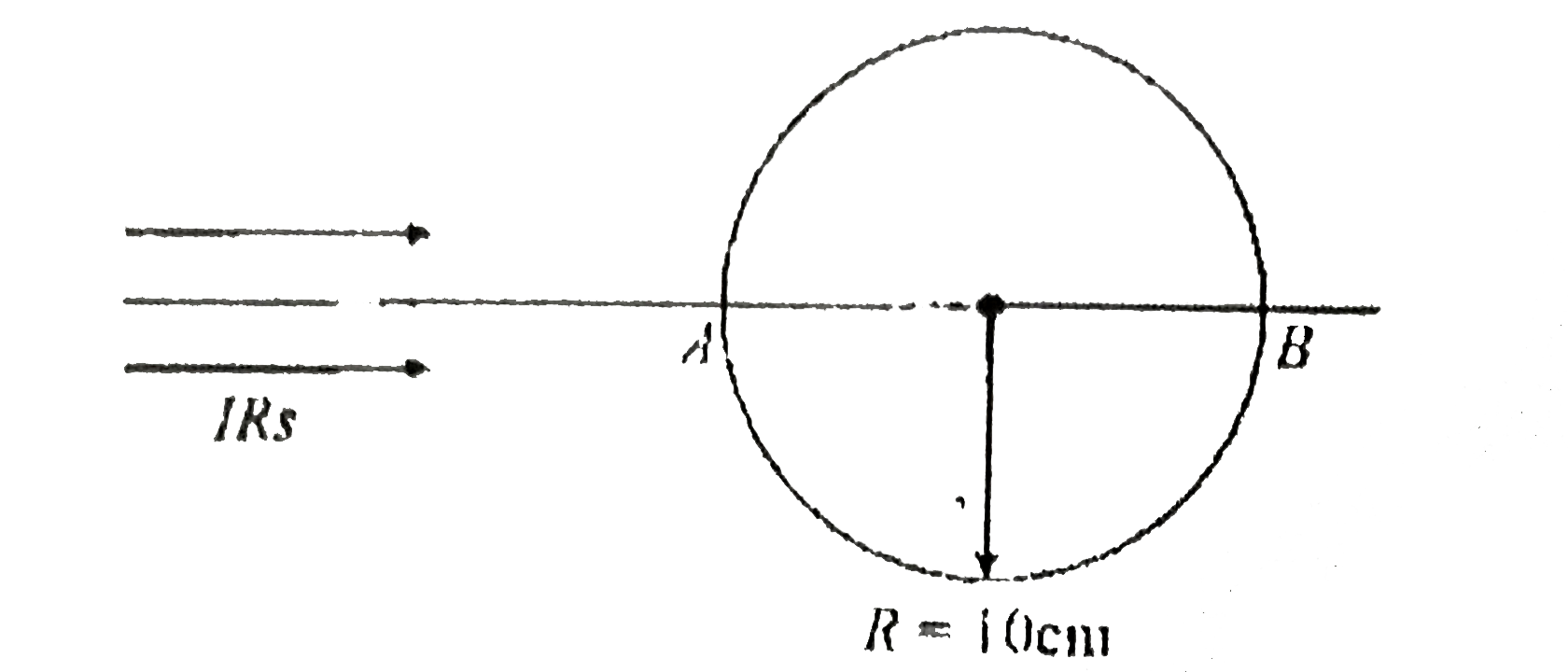 02:38View Solution
02:38View SolutionFigure shows a glass hemisphere M of `mu = (3)/(2)` and radius 10 cm. a point object O is placed at a distance 20 cm behind the flat face which is viewed by an observer from the curved side. Find location of final image after two refractions as seen by observer.
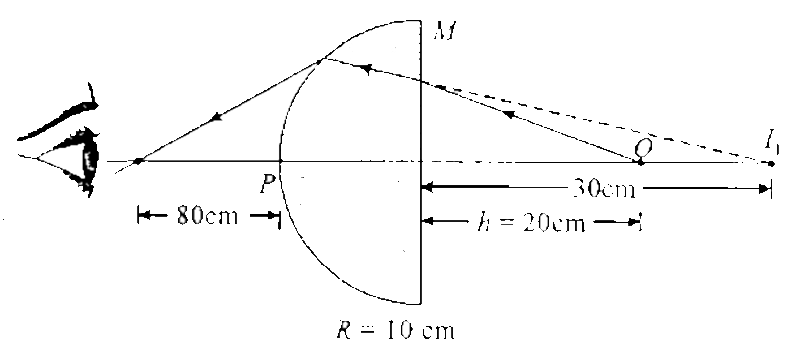 03:19View Solution
03:19View SolutionA ray of light passes through a transparent sphere of refractive index `mu` and radius R. If b is the distance between the incident ray and diameter of the sphere which is parallel to that ray, What is the value of the deviation?
03:14View SolutionA parallel beam of light travelling in water (refractive index ` =4//3)` is refracted by a spherical air bublle of radius 2mm situated in water. Assuming the light rays to be paraxial,
a. Find the position of image due to refraction at first surface and position of the final image.
b. Draw a ray diagram showing the position of both images.03:49View SolutionFigure shows a small object M of length 1mm which lies along a dimentrical line of a glass sphere of radius 1-
 03:24View Solution
03:24View SolutionA long cylindrical tube containing water in closed by an equinvex lens of local length 10 cm in air. A point source is placed along the axis of the tube outside it at a distance of 21 cm from the lens. Locate the final image of the source. Refractive index of the materials of the lens =1.5 and that of water =1.33.
10:12View SolutionA cylindrical glass rod of radius 0.1m and refractive index `sqrt(3)` lies on horizontal plane mirror. A horizontal ray of light moving perpendicular to the axis of the rod is incident on it. At what height from the mirror should the ray be incident so that it leaves the rod at a height of 0.1m above the plane mirror ? At what distance a second similar rod, parallel to the first, be placed on the mirror, such that the emergent ray from the second rod is in line with the incident ray on the first rod ?
09:56View Solution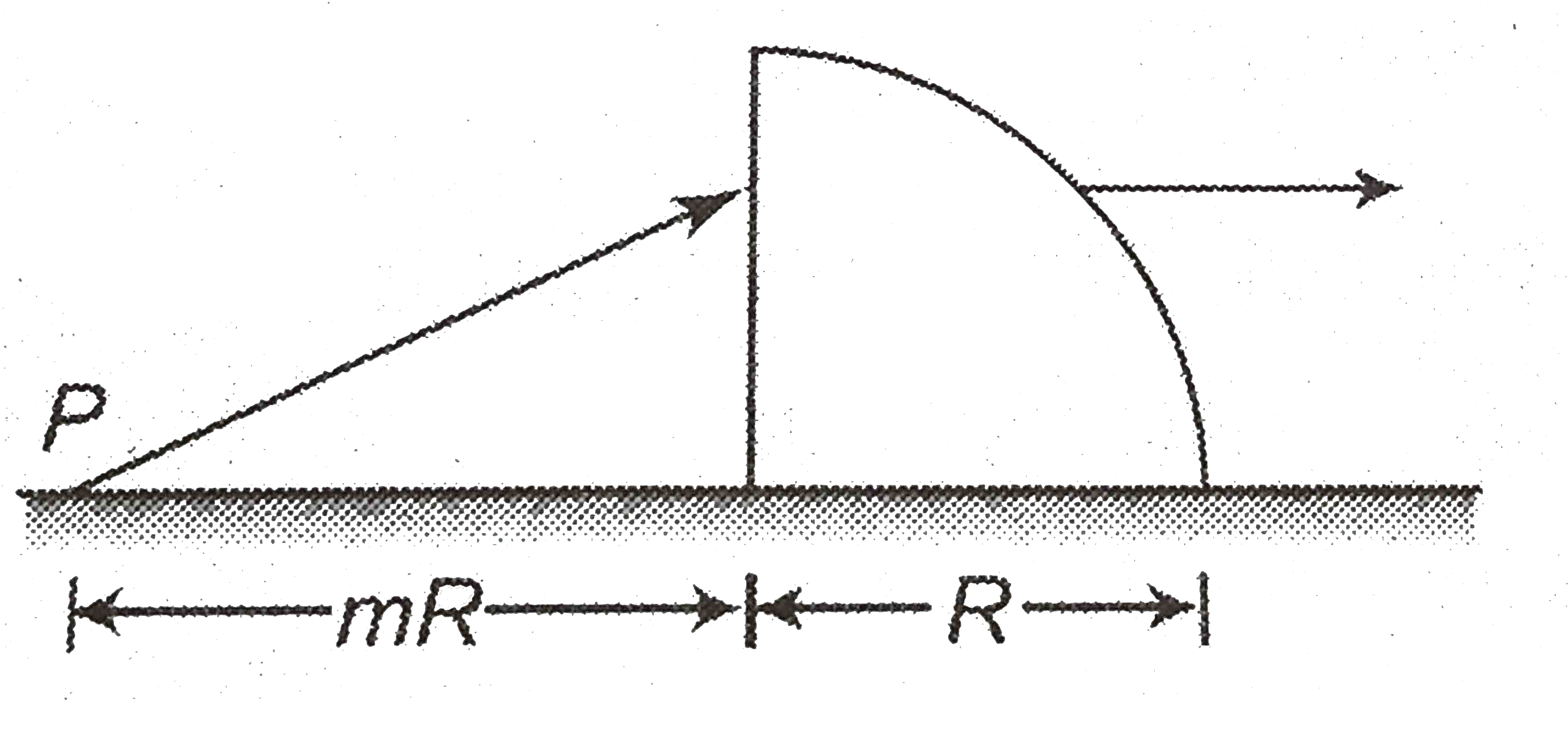
A quarter cylinder of radius R and refractive index 1.5 is placed on a table.A point object P is kept at a distance of mR from it. Find the value of m for whicha ray from P will emerge parallel to the table as shown in the figure.View SolutionFind at what angle a fish inside a lake will see a rising sun. (Take `mu_(omega) = 4//3)`
01:54View SolutionLight falls from glass `(mu=1.5)` to air. Find the angle of incidence for which the angle of deviation is `90^@`.
03:00View SolutionLight is incident at an angle `alpha` on one planar end of a transparent cylindrical rod of refractive index `mu`. Determine the least value of `mu` so that the light entering the rod does not emerge from the curved surface of rod irrespective of the value of `alpha` `
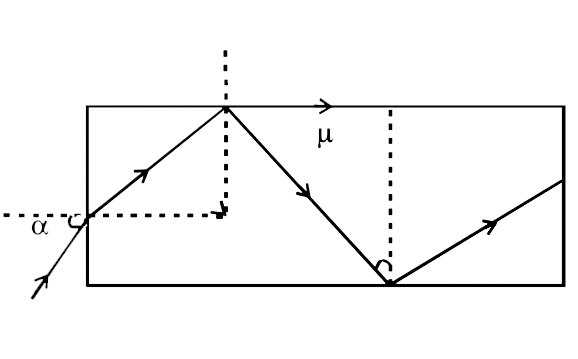 08:14View Solution
08:14View SolutionA rod made of glass `(mu = 1.5)` and of square cross-section is equal is bent into the shape shown in figure. A parallel beam of light falls perpendicurly on the plane flat surface . A . Referring to the diagram, d is the width of a side & R is radius of inner semicircle. find the maximum value of ratio `(d)/(R)` so that all light entering the glass through surface A emerge from the glass through surface B.
_E01_133_Q01.png) 01:45View Solution
01:45View SolutionA prism has refracting angle `30^(@)` and `mu = 2`. One of the mat surface of the prism is polished to make it reflecting. Find the incidence angle of a light ray on other mat surface of prism so that after reflection the ray will retrace the path of incident ray.
05:14View SolutionFind the variation of Refractive index assuming it to be a function of y such that a ray entering origin at grazing incident follows a parabolic path `y = x^(2)` as shown in figure.
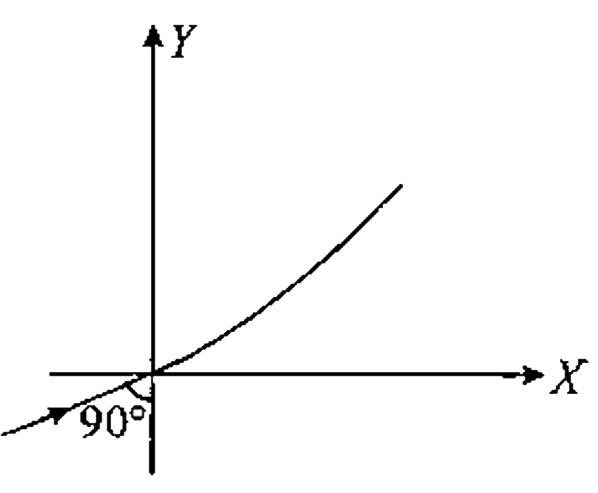 04:22View Solution
04:22View SolutionFind the angle of incidence of a light ray on an equilateral prism of refractive index `mu = sqrt(2)` for which light will suffer minimum deviation also find this minimum deviation angle.
02:48View SolutionThe angle of incidence of a ray of light entering a `60^(@)` prism is `42^(@)`. If ray is just totally reflected at the second face of the prism, determine the refractive index of the prism material for the light.
06:58View SolutionFigure shows a small angles prism angle `4^(@)`and `mu = (3)/(2)`. A light ray almost normally incident on the prism is refracted and falls on a vertical mirror as shown. Find the total deviation of the ray after reflection from the mirror.
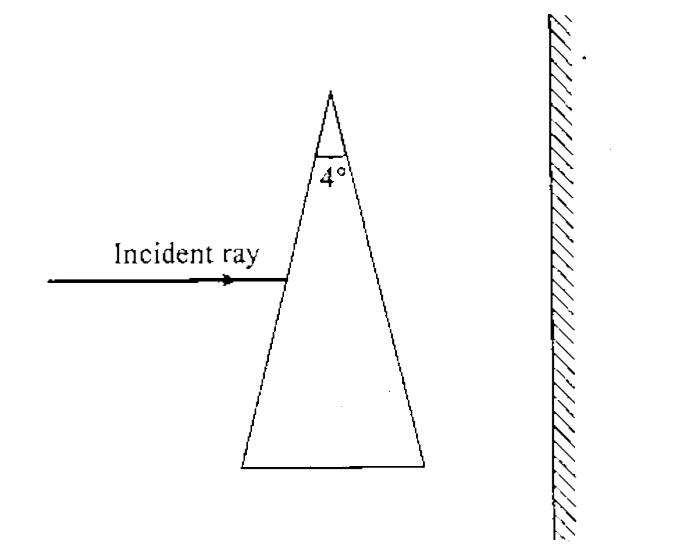 03:02View Solution
03:02View SolutionA right angles prism `(45^(@),90^(@), 45^(@))` of refractive index n has a plate of refractive index `(n_(1)ltn)` cemented to its diagonal face. The assembley is in air. A ray is incident on AB.
a. Calculate the angle of incidence at AB for which the ray strikes the diagonal face at the critical angle.
b. Assuming `n=1.351`, calculate the angle of incidence at AB for which the refracted rey passes through the diagonal face undeviated.
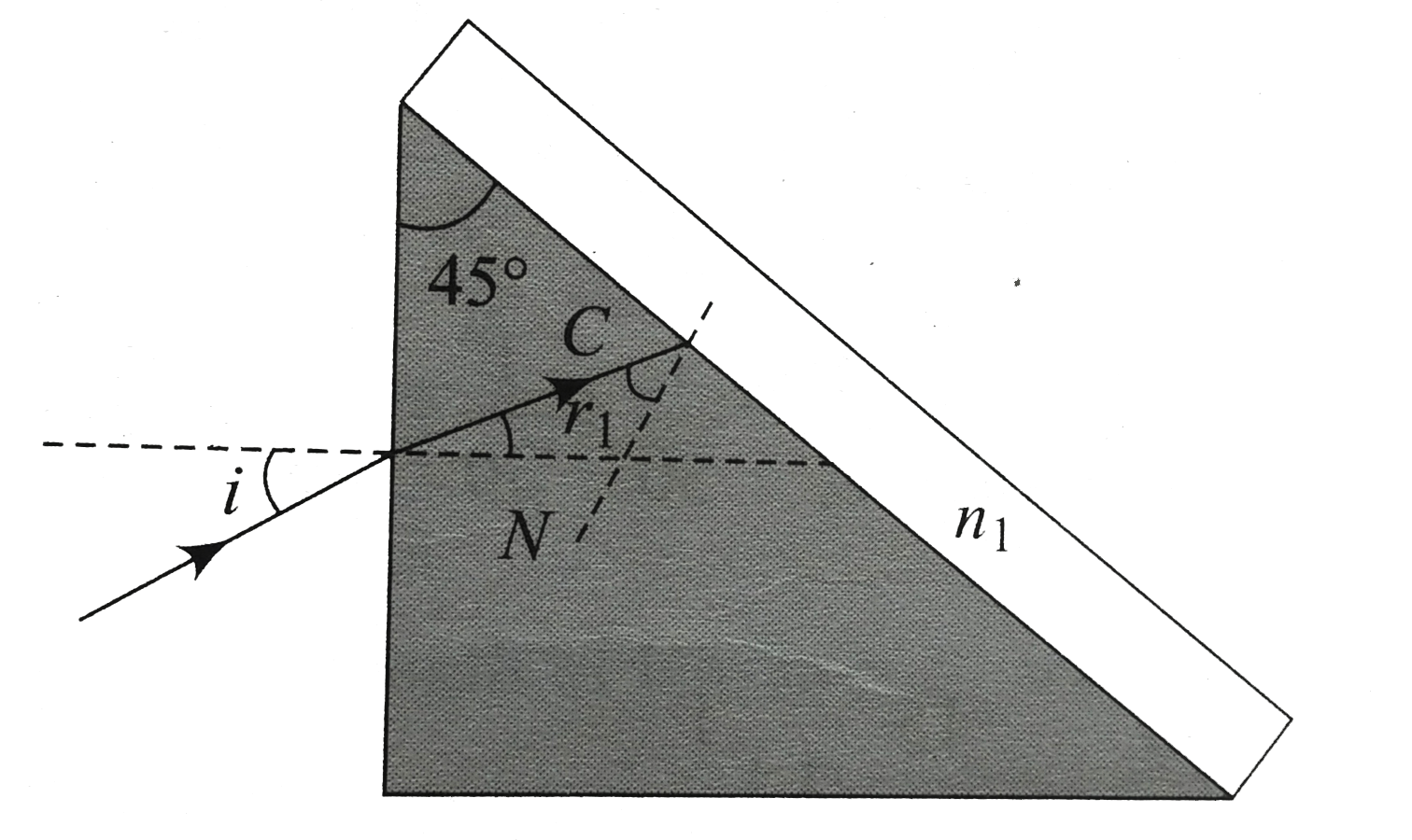 06:56View Solution
06:56View SolutionIn figure, light refracts from material 1 into a thin layer of material 2, crosses that layer, and then is incident at the critical angle on the interface between materials 2 and 3.
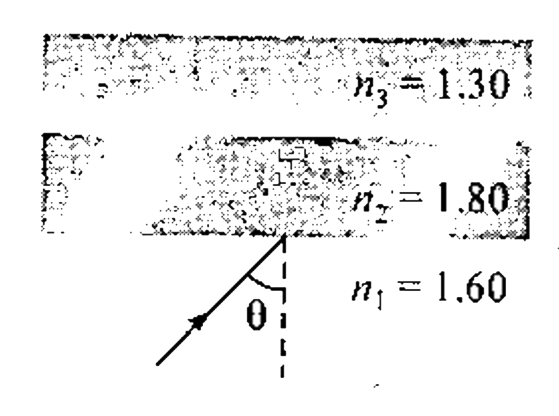
(a) What is the angle `theta`?
(b) If `theta` is decreased, is there refraction of light into material 3 ?04:10View SolutionFind the co-ordinates of image of the point object 'O' formed after reflection from concavemirror as shown in figure assuming prism to be thin and small in size and of prism angle `2^(@)`. Refractive index of the prism material is `3//2`
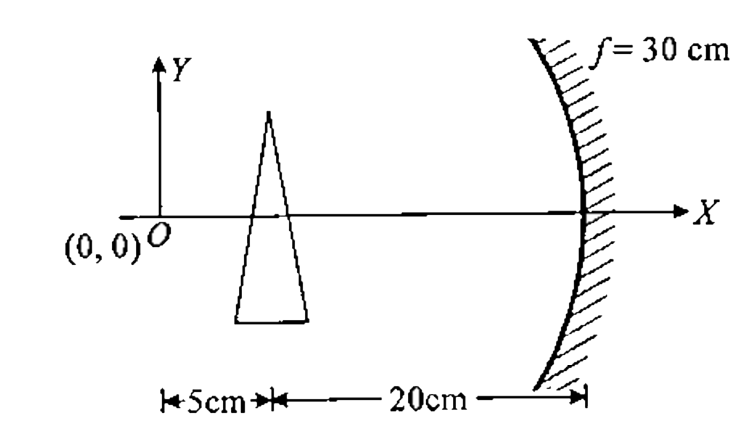 06:44View Solution
06:44View SolutionA monochromatic light is incident on the plane interface AB between two media of refractive indices `mu_(1)` and `(mu_(2)gtmu_(1))` at an angle of incidence `theta` as shown in Fig.
The angle `theta` is infinitesimally greater than the critical angle for the two media so that total internal reflection takes place. Now, if a transparent slab DEFG of uniform thickness and of refractive index `mu_(3)` is introduced on the interface (as shown in the figure), show that for any value of `mu_(3)` all light will ultimately be reflected back into medium II.
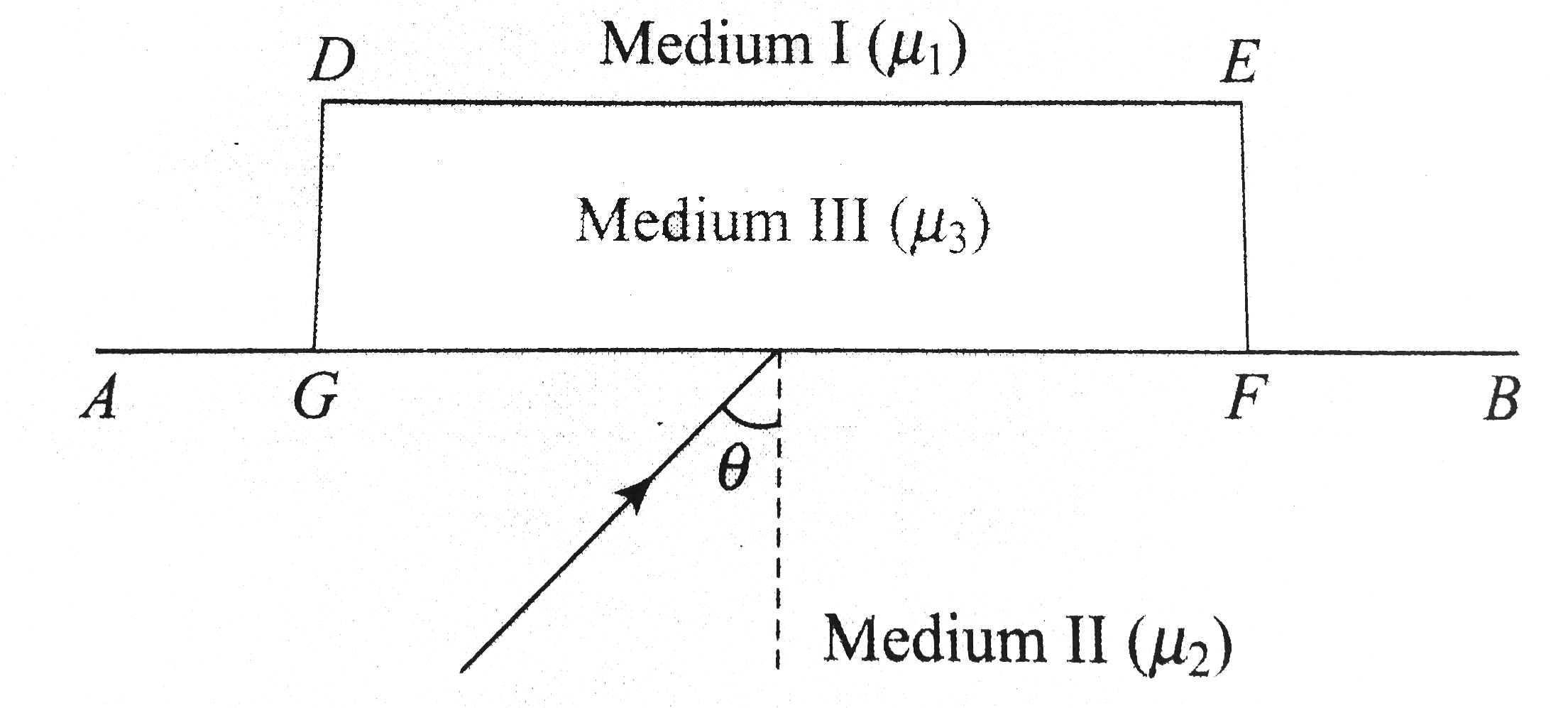 05:09View Solution
05:09View SolutionFor a prism, `A=60^(@), n=sqrt(7//3)` . Find the minimum possible angle of incidence, so that the light ray is refracted from the second surface. Also, find `delta_(max)`.
05:33View SolutionFocal length of a thin lens in air, is 10 cm. Now medium on one side of the lens is replaced by a medium of refractive index `mu = 2`. The radius of curvature of surface of leng, in contact with the medium, is 20 cm. Find the point on principal axis where parallel rays incident on lens from air parallel to axis will converge.
 06:03View Solution
06:03View SolutionA biconvex lens has focal length 50 cm and the radius of curvature of one surface is double that of other. Find the radii of curvature if refractive index of lens material is 2.
04:05View SolutionA convex lens of focal length 20 cm is placed at a distance 5 cm from a glass plate `(mu = (3)/(2))` of thickness 3 cm. an object is placed at a distance 30 cm from lens on the other side of glass plate. Locate the final image produced by this optical setup.
06:25View SolutionA diverging lens of focal length 20 cm is placed coaxially 5 cm toward left of a converging mirror of focal length 10 cm. Where would an object be placed toward left of the lens so that a real image is formed on object itself.
04:01View SolutionA convex lens is held `45 cm` above the bottom of an empty tank. The image of a point at the bottom of a tank is formed `36 cm` above the lens. Now, a liquid is poured into the tank to a depth of `40 cm.` It is found that the distance of the image of the same point on the bottom of the tank is `48 cm` above the lens. Find the refractive index of the liquid.
04:18View SolutionAn object of height 4 cm is kept to the left of and on the axis of a converging lens offocal length 10cm at a distance of 15cm from lens. A plane mirror is placed inclined at `45^(@)` to the lens axis, 10 cm to the right of the lens.Find the position and size of the image formed by the lens and mirror combination. Trace the path ofthe rays forming the image.
08:10View Solution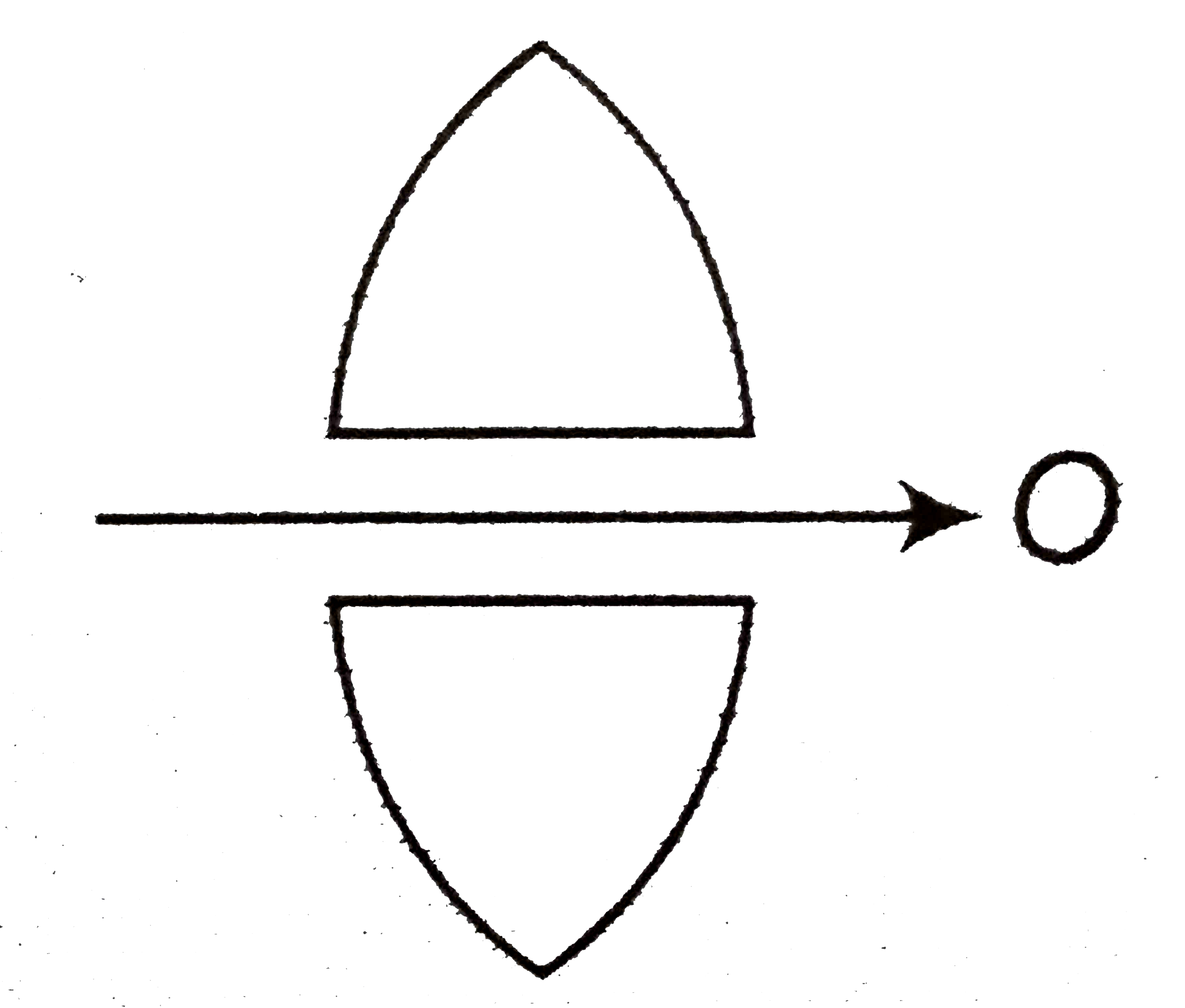
A point object is placed at a distance of 0.3 m from a convex lens (focal length 0.2 m) cut into two halves each of which is displaced by 0.0005 m as shown in the figure. Find the position of the image . If more than one image is formed find their number and the distance between them.04:36View SolutionA thin converging lens with focal length `f = 25 cm` projects the image of an object on a screen removed from the lens by a distance `l == 5.0 m`. Then the screen was draws closer to the lens by a distance `Delta l = 18 cm`. By what distance should the object be shifted for its image to become sharp again ?
07:06View SolutionDetermine the position of the image produced by an optical system consisting of a concave mirror with a focal length of `10 cm` and a convergent lens with a focal length of `20 cm.` The distance from the mirror to the lens is `30 cm` and from the lens to the object is `40 cm.` Consider only two steps. Plot the image.
04:13View SolutionA strong source of light when used with a convex lens produces a number of images of the source owing to feeble internal reflections and refraction called flare spots as shown in figure . These extra images are `F_(1),F_(2)`. If `F_(n)` is the position of `n^(th)` flare spot, then show that
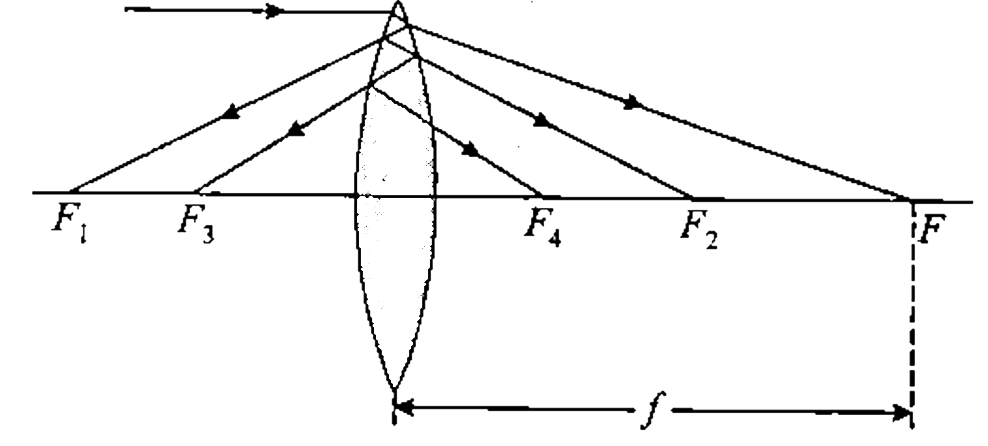 03:57View Solution
03:57View SolutionA small fish, 0.4m below the surface of a lake, is viewed through a simple converging lens of focal length 3m. The lens in kept at 0.2m above the water surface such that the fish lies on the optical axis of the lens. Find the image of the fish seen by the observer. The refractive index of water is `4//3`.
01:58View SolutionA point object is placed at a distance of 15 cm from a convex lens. The image is formed on the other side of lens at a distance 30 cm from lens. When a concave lens is placed in contact with convex lens, image is shifted away further by 30 cm. calculate the focal lengths of the two lenses.
02:10View SolutionThe figure below shows a thin plano-convex lens of refractive index `mu_(1)` and a thin plano-concave lens of refractive index `mu_(2)`, both having same radius of curvature R of their curved surfaces. Another thin lens of refractive index `mu_(3)` has same radius of curvature R on the two surface between the plano-convex and plano-concae lenses that the plane surfaces are parallel to each other. Find the focal length of the combination.
 02:19View Solution
02:19View SolutionThe convex surface of a thin concave-convex lens of glass of refractive index 1.5 has a radius of curvature 20 cm. The concave surface has a radius of curvature 60 cm. The convex side is silvered and placed on a horizontal surface as shown in figure. (a) Where should a pin be placed on the axis so that its image is formed at the same place ? (b) If the concave part is filled with water (mu = 4/3), find the distance through which the pin should be moved so that the image of the pin again coincides with the pin.
 08:54View Solution
08:54View SolutionThe radius of curvature of the curved surfaces of an equiconvex lens is 32 cm and its refractive index is `mu = 1.5`. One of its side is silvered and placed 14 c away from an object as shown in figure. At what distance x should a second convex lens of focal length 24 cm be placed so that the image coincides with the object.
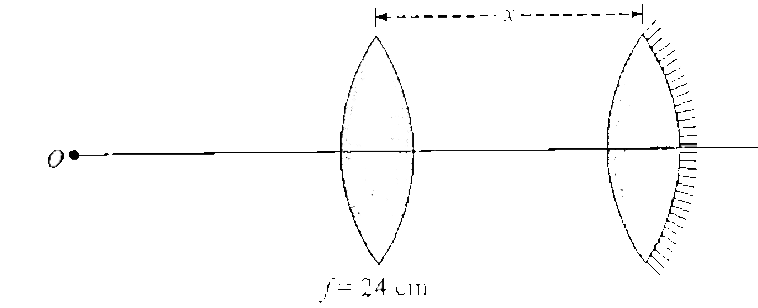 05:26View Solution
05:26View SolutionA point source of light is placed inside water and a thin converging lens ofrefractive index `mu_(2)` is placed just outside the plane surface of water. The image of the source is formed at a distance x from the surface of water. If the lens is now placed just inside water and the image is now formed at a distances' from the surface of water, show that
`(1)/(x) -(1)/(x_(1)) = (mu_(1)-1)/(mu_(2)-1) xx (1)/(f)`,
Where f is the focal length of the lens and `mu_(1)` is the refractive index of water.12:38View SolutionA thin plano-convex lens of focal length f is split into two halves. One of the halves is shifted along the optical axis as shown in figure. The separation between object and image planes is 1.8 m. The magnification of the image, formed by one of the ball lens is 2. Find the focal length of the lens and separation between the two halves. Draw the ray diagram for image formation.
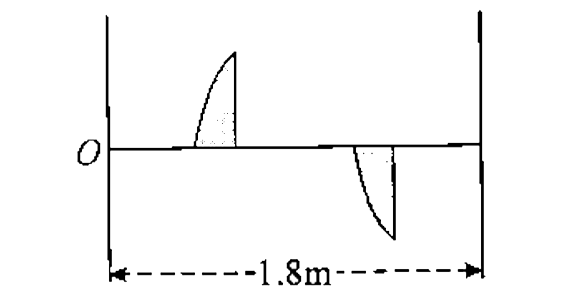 04:09View Solution
04:09View SolutionA thin converging lens is placed between an object and a screen whose position are fixed. There are two positions of the lens at which the sharp image of the object is formed on the screen. Find the transverse dimension of the object if at one position of the lens the image dimension equal `h' = 2.0 mm` and at the other, `h'' = 4.5 mm`.
02:15View SolutionA thin equiconvex lens of glass of refractive index `mu=3//2` & of focal length `0.3m`in air is sealed into an opening at one end of a tank filled with water `(mu=4//3)` .On the opposite side of the lens ,a mirror is placed inside the tank on the tank wall perpendicular to the lens axis ,as shown in figure .the separation between the lens and the mirror is `0.8m`A small object is placed outside the tank in front of the lens at a distance of `0.9`m form the lens along its axis .Find the position (relative to the lens)of the image of the object fromed by the stsyem.
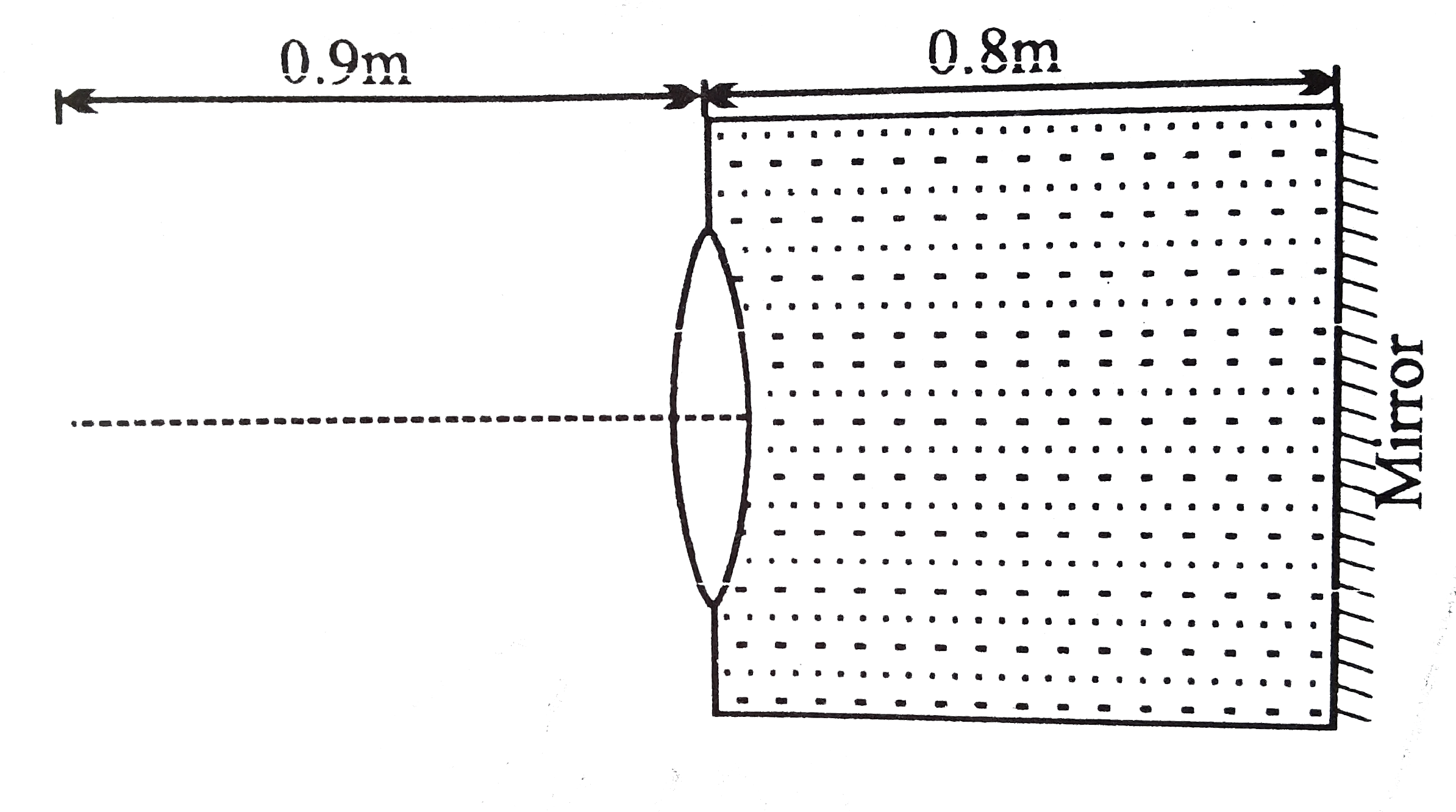 11:28View Solution
11:28View SolutionBottom of a glass beaker is made of a thin equi-convex lens having bottom side silver polished as shown in the figure. Water is filled in the beaker upto a height 4m. The image of poin to bject,floating at middle point of beaker at the surface of water coincides with it. Find out ther adius of curvature of the lens.Given that refractive index of glass is 3/2 and that of water is 4/3.
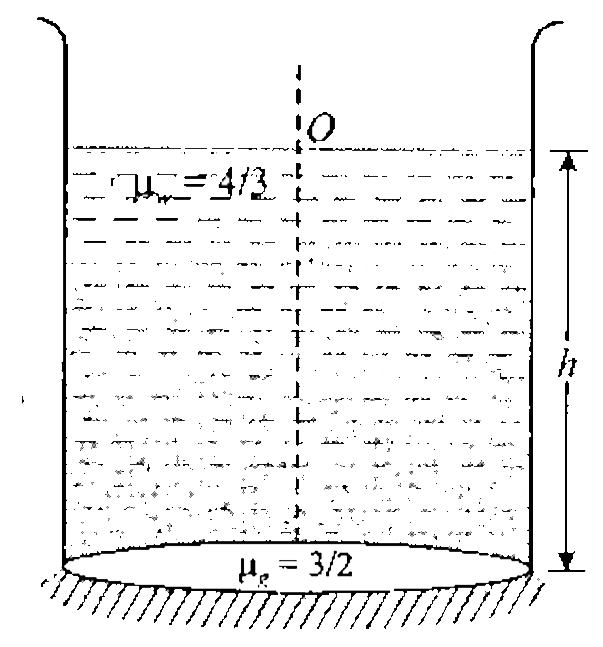 03:10View Solution
03:10View SolutionAn achromatic convergent lens of focal length `150 cm` is made by combining flint and crown glass lenses. Calculate the focal length of both the lenses and point out which one is divergent if the ratio of the dispersive power of flint and crown glasses is `3:2.`
04:21View SolutionCalculate the angle of a prism of dispersive power `0.021` and refractive index `1.53` to form an achromatic combination with prism of angle `4.2^@`, and dispersive power `0.045`, having refractive index `1.65`. Find also the net deviation.
03:00View SolutionA prism of angle `60^(@)` is made of glass of refractive index 1.50 for red and 1.56 for violet. Find the angular separation of these rays when a narrow pencil of composite light is incident at minimum deviation.
01:26View SolutionA thin biconvex lens is placed with its principal axis first along a beam of parallel red light and then along a beam of parallel blue light. If the refractive indices of the lens for red and blue light are respectively 1.514 and 1.524 and if the radius of curvature of the faces are 30 cm and 20 cm, calculate the sepration of for red and blue light. If the focal length for the mean colour (yellow) is 23.1 cm, find the dispersive power of the material of the lens.
05:04View SolutionTwo parallel beams of light P and Q (separation d) containing radiation of wavelengths `4000A` and `5000A` (which are mutually coherent in each wavelength separately) are incident normally on a prism as shown in fig. The refractive index of the prism as a function of wavelength is given by the relation. `mu(lamda)=1.20+(b)/(lamda^(2))` Where `lamda` is in `A` and b is positive constant. The value of b is such that the condition wave length and is not satisfied for the other.
(a) Find the value of b.
(b) find the deviation of the beams transmitted through the face AC. (c) A convergent lens is used to bring these transmitted beams into focus. If the intensities of transmission form the face AC, are 41 and I respectively, find the resultant intensity at the focus. `
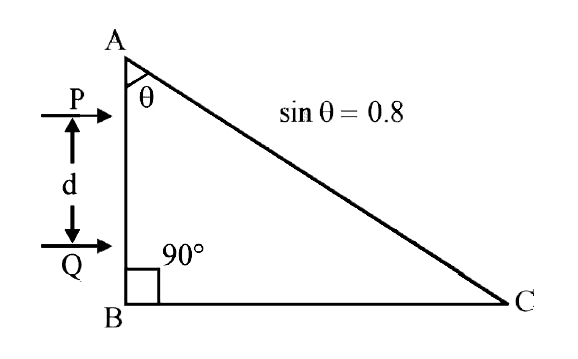 11:36View Solution
11:36View SolutionA short-sighted man, the accommodation of whose eye is between 12 cm and 60 cm wears spectacles through which he can see remote objects distinctly. Determine the minimum distance at which the man can read a book through his spectacles.
02:40View SolutionThe focal lengths of the objective and eyepiece of a microscope are 4mm and 25 mm respectively, and the length of the tube is 16cm. If the final image is formed at infinity and the least distance of distinct vision is 25 cm, then calculate the magnifying power of the microscope.
06:49View SolutionA telescope has an objective of focal length `50cm` and an eyepiece of focal length `5cm.` The least distance of distinct vision is `25cm.` The telescope is focused for distinct vision on a scale `2m` away from the objective. Calculate (a) magnification produced and (b) separation between objective and eyepiece.
05:13View SolutionA compound microscope is used to enlarge an object kept at a distance `0.03m` from cuts objective which consists of serval convex lenses in contact and has focal length `0.03m`. If a lens focal length `0.1m `is removed from the objective, find out the distance by which the eye-piece of the microscope must be moved to refocus the image.
04:38View SolutionIn a compound microscope, the objective and eye piece have focal lengths `0.95 cm and 5 cm` respectively, and are kept at a distance of `20 cm`. The final image is formed at a distance of `25 cm` from the eye piece. Calculate the position of the object and the total magnification.
03:57View SolutionThe focal lengths of the objective and eye piece of an astronomical telescope are `25 cm and 2.5 cm` respectively. The telescope is fucussed on an object `1.5 m` from objective, the final image being formed `25 cm` from eye of the observer. Calculate the length of the telescope.
02:51View SolutionA short-sighted person cannot see objects situated beyond 2m from him distinctly. What should be the power of the lens which he should use for seeing distant objects clearly?
03:14View Solution
Illustrative Example questions and complete solutions for chapter GEOMETRICAL OPTICS of GK PUBLICATIONS PHYSICS (HINGLISH) of Class 12
All Exercises from PHYSICS GALAXY Class 12 PHYSICS GEOMETRICAL OPTICS
- Advance MCQs with One or More Options Correct
- Conceptual MCQs Single Option Correct
- Discussion Question
- Illustrative Example
- Numerical MCQs Single Options Correct
- Practive Exercise 5.1
- Practive Exercise 5.2
- Practive Exercise 5.3
- Practive Exercise 5.4
- Practive Exercise 5.5
- Practive Exercise 5.6
- Practive Exercise 5.7
- Practive Exercise 5.8
- Practive Exercise 5.9
- Unsolved Numerical Problems
